Feature
How New York City’s Largest Food Rescue Organization Stepped Up During the SNAP Crisis
Climate•9 min read
Explainer
News anchors broadcast about it, scientists are scrambling for ways to reverse it, and consumers unknowingly contribute to it. What is it? Climate change.
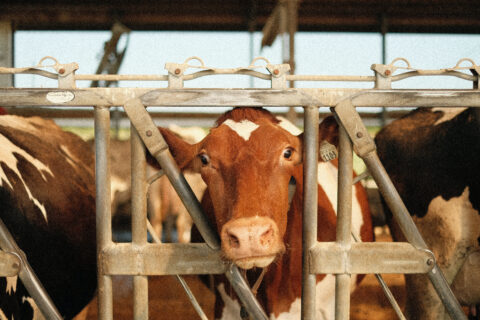

Words by Taylor Meek
The effects of the climate crisis are becoming apparent as the global temperature rises, ice sheets shrink, and natural disasters increase in frequency.
 This story is part of Covering Climate Now, a global collaboration of more than 250 news outlets to strengthen coverage of the climate story.
This story is part of Covering Climate Now, a global collaboration of more than 250 news outlets to strengthen coverage of the climate story.Gases such as carbon dioxide, nitrous oxide, methane, and chlorofluorocarbons (CFCs) are released into the atmosphere and trap heat from the sun – thus warming the planet. These gases are called “greenhouse gases” (GHG) since they build up a layer in the atmosphere that’s more reflective than would be normal, analogous to how a gardener’s greenhouse is warmed by the sun.
Since the Industrial Revolution in the late 1700s, GHG emissions like CO2 have entered our atmosphere at alarming rates. In the past decade alone, the planet has experienced its warmest years to date.
So why does a warming planet spell disaster and how does animal agriculture fit into this rapid warming process? Animal agriculture is one of the largest contributors of human-made GHG emissions and is also a primary cause of deforestation, heavy resource use, water and air pollution, and biodiversity loss.
A lot of people don’t seem to be alarmed when they hear that the planet is warming. “The planet has fluctuated in temperature for thousands of years, what’s the big deal?” they scoff. This mentality is just as toxic as the fumes leaking into the atmosphere as we speak.
As the global temperature continues to rise, heat-waves will grow longer and hotter, natural disasters will become more intense, sea levels will rise, the production of certain crops will be disrupted, and coral reefs will die – leading to the potential death of 25% of fish species who depend on the reefs for survival and reproduction.
Global warming isn’t just a threat to marine life. Its effects on certain crops are a threat to human, animal, and plant life. Rising temperatures disrupt weather patterns, which yield excessive weed overgrowths, increased plant diseases, and insect infestations. Increased rain leads to flooding which has the potential to drown scores of crops, while on the opposite end, reduced water supply in certain areas can parch them.
Though irreversible damage has already been done, there are still plenty of ways that everyone – from large corporations down to a single consumer – can help slow climate change and ease some of its effects. Consumers can start by eating less meat and dairy and purchasing local produce, while large corporations can invest in plant-based or lab-grown meat and dairy products which save significant amounts of water, energy, and land during production.
Banning plastic bags and incentivizing the use of solar panels might be a start toward calming environmental distress, but in order to tackle this climate emergency, we need policymakers around the globe to realize the harsh impact current agricultural practices have on the planet and that they have the power to help.
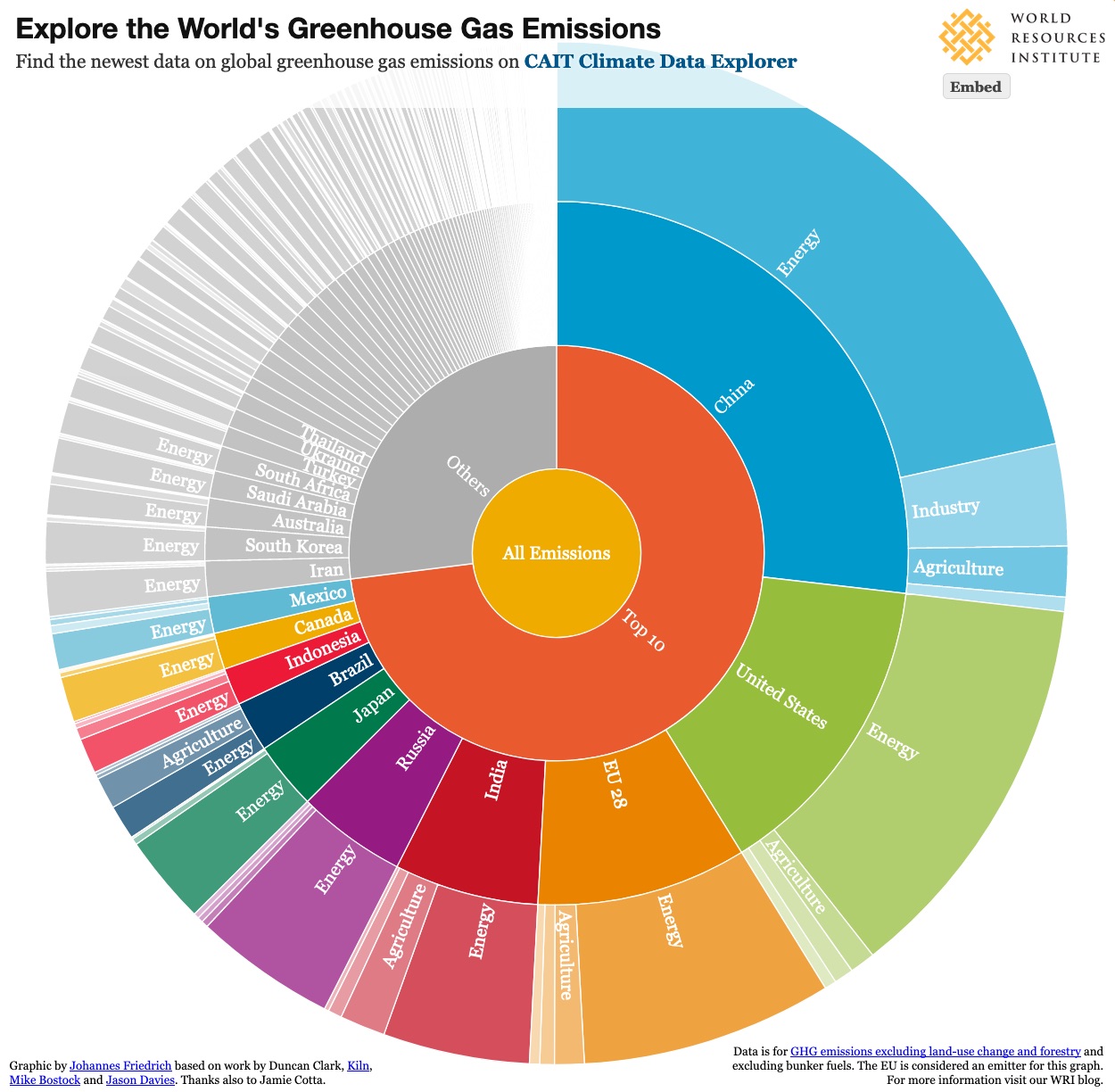
This interactive chart displays the top emissions produced by each country. The United States, China and the European Union are the world’s top three GHG emitters.
With great power comes great responsibility, and the most impactful propositions to assist our planet would be the refocusing of taxpayer money to support sustainability programs and passing environmentally-conscious bills focussing on animal agriculture.
Unfortunately, U.S. policymakers have retracted or plan to retract from environmentally-focused programs like the Clean Water Act (via the 2018 Farm Bill) and the Paris Agreement and instead cater to animal agriculture by permitting leniency in environmental regulations and requirements.
Instead of passing bills that threaten the health of our people and planet, policymakers around the world can implement climate-protective measures such as setting local emission goals, incentivizing climate-friendly power sources like wind, solar, and water instead of “dirty energy” like coal and oil, and enacting stricter regulations (as well as penalizations) on factory farm emissions – one of the largest climate change culprits.
Animal agriculture is one of the largest contributors to climate change due to its heavy resource use, chemical runoff, and excessive GHG emissions. In the U.S., around 40 percent of all agricultural emissions stem from animal agriculture, and two-thirds of that comes from ruminants animals, mostly cows.
The increasing demand for meat and dairy means an increase in the number of cattle raised, land and other resources used, and emissions released into the atmosphere.
Methane, according to the Food and Agriculture Organization (FAO), is the most emitted gas in animal agriculture, accounting for around 40 percent of the sector’s emissions.
Beef and dairy cattle are the largest producers of methane due to enteric fermentation during digestion, which accounts for one-third of emissions from the U.S. agricultural economic sector, according to the EPA.
Methane is a GHG more potent and effective at trapping heat than carbon dioxide, and an estimated 20 percent of environmental warming can be attributed to it.
Worldwide methane levels spiked after the Industrial Revolution, and have recently surged again after remaining steady since the 1990s.
Due to the demand for meat and cheese continuing to rise, there are over one billion cows on the planet producing this gas every day, along with any methane released in the spreading of manure, clearing of grazing areas, and production of animal feed.
Carbon dioxide is another GHG heavily found within animal agriculture. Factory farms release CO2 in a variety of ways: deforestation to make room for crops to feed animals and clear grazing land, use of chemical fertilizers to grow crops, desertification from over-grazed or over-farmed pastures, and the naturally produced CO2 from animals and decompositional bacteria.

One of the most destructive yet undermentioned GHGs is nitrous oxide (N2O). This gas is 300 times more potent than carbon dioxide at warming the planet and can be found in manure and fertilizers used to grow feed crops for animals. N2O can linger in the atmosphere for over a century, and animal agriculture accounts for around 65 percent of global anthropogenic (human-induced) N2O emissions.
Billions of animals are raised for meat and dairy every year around the world, meaning more land is cleared, more crops are grown, more fertilizer is applied, more manure is produced, and more GHGs are released into the atmosphere.
In 2018, over 4.5 billion bushels of soybeans were produced in the United States and around 70 percent of that was used for feeding chickens, pigs, and cows.
In order to make room for all of these crops, farmers plow forests, grasslands, and wetlands from the U.S. to Brazil and everywhere in between.
Clearing land at such a high rate results in deforestation, soil erosion, foregone carbon absorption, and animal habitat loss. As we have seen from recent Amazon fires, clearing land for animal agriculture is detrimental to our planet and the animals.
In addition to extreme land use, meat and dairy production require copious amounts of freshwater.
Less than 1 percent of freshwater on this planet is usable by humans, and an unsettling 70 percent of that is used for growing food and raising farm animals.
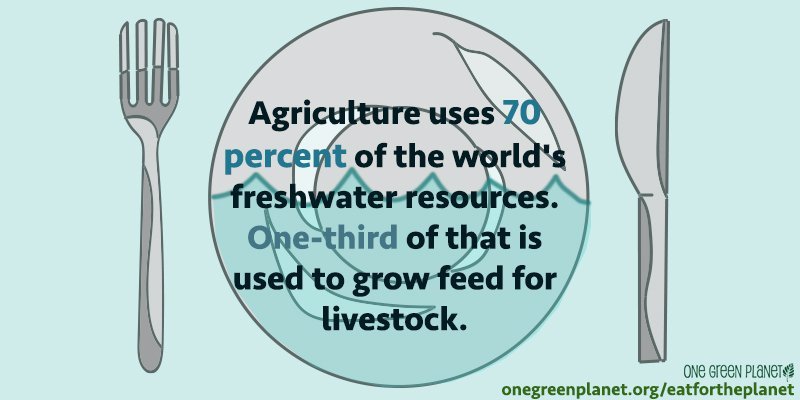
Animal agriculture is a leading contributor to the world’s water depletion and freshwater contamination from farm runoff.
Animal agriculture is an incredibly resource-intensive industry, but that is not the only way it affects the planet. Billions of animals constantly grazing means that waste is inevitable — a lot of it.
This waste, and the bacteria within it, can seep into the ground or get washed away by rain or flooding. Water contamination from animal agriculture can also originate from faulty waste-management systems or direct dumping into waterways.
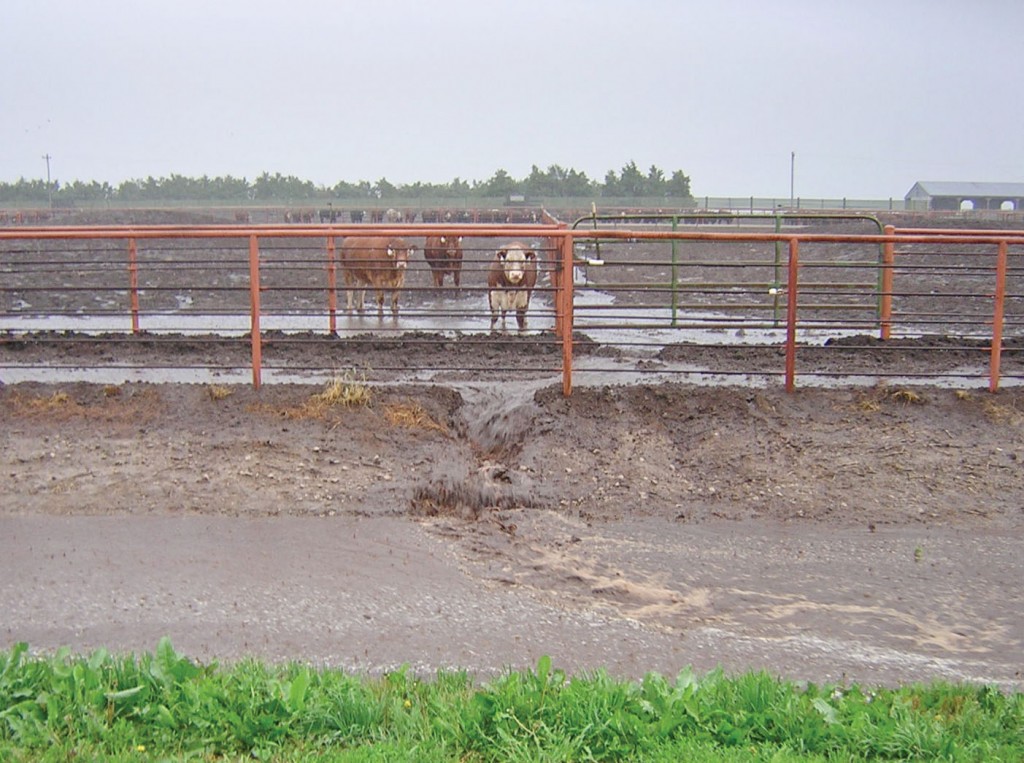
A mature dairy cow produces around 14 gallons (120lb) of feces and urine each day. Since there are around 264 million dairy cows in the world, that means 3.7 billion gallons of excrement can be produced in a single day.
All of that waste has to go somewhere, and most farms store it in open-air lagoons or use it as fertilizer. As if ponds full of animal waste weren’t enough, these lagoons also consist of blood, bedding, antibiotic residues, hormones, and anything else small enough to get swept up or hosed out of the barns and buildings.
These lagoons are often lined only with clay, making them susceptible to leaks which seep waste into the groundwater. When storms roll through, like Hurricane Florence, floodwaters wash this waste into rivers, streams, and lakes resulting in extremely unsanitary conditions.
Nitrogen, phosphorus, and ammonia from animal waste can lead to dead zones in our oceans caused by algal blooms which deplete oxygen and choke out marine life.
Global warming leads to warmer ocean temperatures which hinder coral growth and cause large portions to die. Coral reefs are one of the most diverse ecosystems on the planet and their demise means the death or relocation of countless sea creatures.
Carbon dioxide is a major contributor to ocean acidification, which in part comes from deforestation for feed crops and farm runoff. Carbonic acid is created when saltwater and carbon dioxide mix, and this acid bleaches coral reefs, dissolves oxygen from the water, and hinders the growth of calcium carbonate which crabs, lobsters, and other shellfish rely on for protection.
Over 50 percent of the air we breathe comes from the ocean via marine plants and phytoplankton, so a threat to the delicate ocean ecosystem is a threat to life as we know it.
Biodiversity is life on earth — from the tiniest phytoplankton to the largest blue whale, the planet needs them all and their specific roles to function properly.
A warming climate wreaks havoc on the delicate ecosystems of the world, and humans are contributing to this disruption and destruction by burning fossil fuels, polluting, and supporting the resource-intensive meat and dairy industries.
Global desire for meat, dairy, and fossil fuels is contributing to what scientists are calling the sixth mass extinction by destroying habitats, displacing animals, and polluting our planet.
When a species dies off and becomes extinct, the whole ecosystem is impacted and must adjust accordingly. The current rate of extinction is comparable to the mass extinction of dinosaurs 65 million years ago.
Climate change affects all parts of an ecosystem – both land and sea, from bacteria to plants to animals. Invasive crops, infestation of insects, overpopulation of animals, and even declining oxygen levels are all results of a changing climate.
Plants are one of the most important pieces of the planetary puzzle, and without them, life on earth would be nearly impossible.
They provide shelter and resources to animals and insects, absorb carbon dioxide and release oxygen, improve soil quality, and provide us with food and medicine.
Factory farming and fossil fuel burning are changing the planet, so how do plants cope?
Some plant species are able to alter the way they grow to adapt to a changing climate. Research from the University of Edinburgh found that plants in the Arctic are growing taller as a result of warmer temperatures.
This adjustment might seem harmless, but shorter plants trap more snow, insulating the soil from freezing temperatures. Warmer weather and taller plants could thaw frozen carbon banks in the soil and release GHGs into the atmosphere. Snow-covered grassland also reflects sunlight more efficiently back into space than a wintery forest does.
Naturally, unlike animals, it is much harder for plants to relocate to warmer or cooler areas, depending on their biological needs. When plants grow taller to cool themselves, the strength of their stalks is jeopardized.
This is seen often in grain harvesting, for example. Weak stalks are more susceptible to breaking and bending during hard rain storms or high winds. These plants are often less fruitful and even their kernels can be affected by lacking key nutrients.
Plants above sea level aren’t the only ones feeling the negative effects of climate change. Marine plants and phytoplankton are responsible for over half of the oxygen we breathe, so if they go down, so do we.
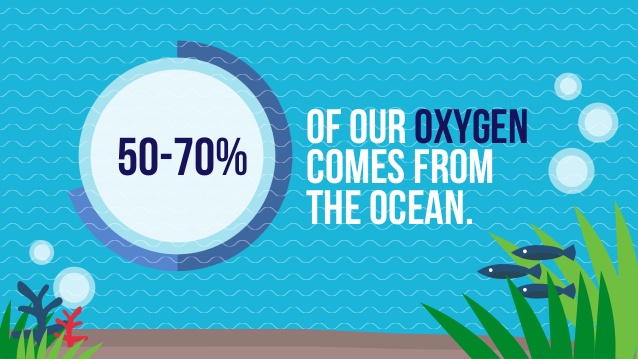
Carbon dioxide from animal agriculture, burning fossil fuels, and other human activities are poisoning the ocean and its inhabitants.
Carbonic acid, created from excess carbon dioxide, bleaches coral reefs, dissolves oxygen from the water, and hinders the growth of calcium carbonate which crabs, lobsters, and other shellfish rely on for protection.
Disturbances in plant life, above or below the surface, carry over to the animals who depend on them for survival.
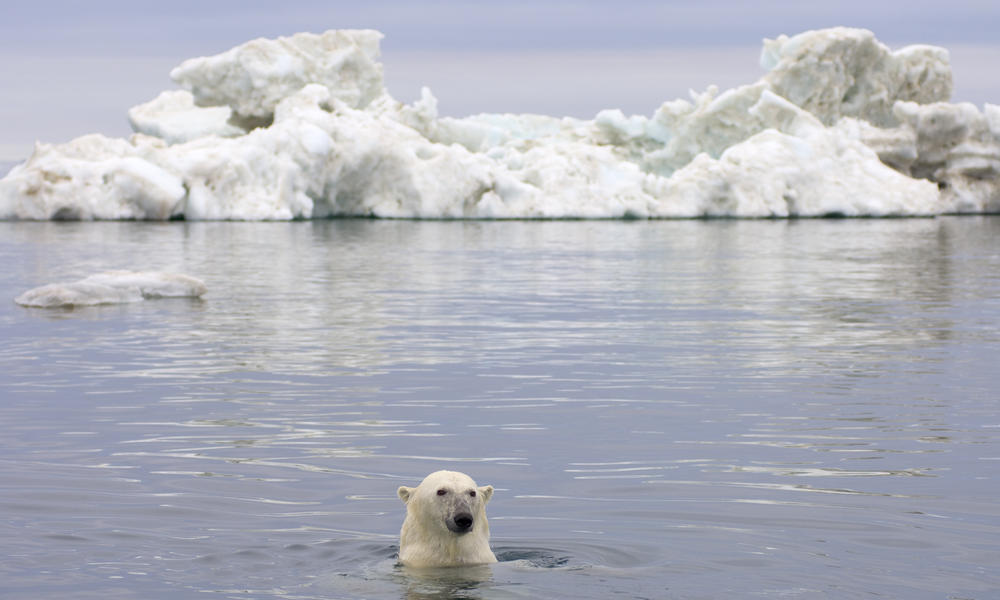
A warming climate can disrupt the delicate balance of reproductive cycles, migration patterns, and food routines for animals. Warmer weather and increased rainfall means certain insects, like mosquitoes, have extended breeding periods.
Other animals like polar bears, manatees, and Bengal tigers are already struggling to adapt to changing climates. Polar bears are losing their habitats due to melting ice, while manatee migration patterns are disrupted due to changing water temperatures and increased frequency of hurricanes.
Bengal tigers and other land mammals are being displaced by increasing water levels, which impacts their natural habitats and interferes with feeding routines.
Clearing land for animal agriculture, palm oil, and infrastructure encroaches on animals’ natural habitats, causing them to move to other areas they have difficulty acclimating to or die if they are unable to adapt.
Orangutans, jaguars, giant pandas, dolphins, and rhinos are just a few animals on the brink of extinction. The world’s largest mammal, the blue whale, is facing extinction due to extreme commercial whale hunting around the world.
Commercial fishing creates a slew of problems for ocean dwellers. Technological advances enable fishermen to track and capture large amounts of fish at one time. This practice is not only damaging to fish populations (i.e. Atlantic cod), but bycatching, the portion of a commercial fishing catch that consists of marine animals caught unintentionally, traps large endangered animals like dolphins, manatees, and turtles in fishing nets where they often get injured or die.
Some species of plants and animals, like the tawny owl, are able to adapt to climate change by adjusting their size and appearance. These changes are considered “plastic” or non-inheritable, meaning they will not stick for future generations.
The adaptivity of plants and animals is limited, so mitigation tactics must improve or our planet and its inhabitants, including humans, will suffer the consequences.
Climate change doesn’t just impact the planet’s temperature; it affects weather patterns, animal migration and mating patterns, GHG emissions in our atmosphere, and ultimately, the way we grow our food.
If climate change continues to worsen, the planet could lose important crops like corn, wheat, and rice due to insect infestations and climate-driven plant diseases. This would force humans to adapt and find new sources of nutrients which could be fatal in developing countries that rely heavily on these crops.
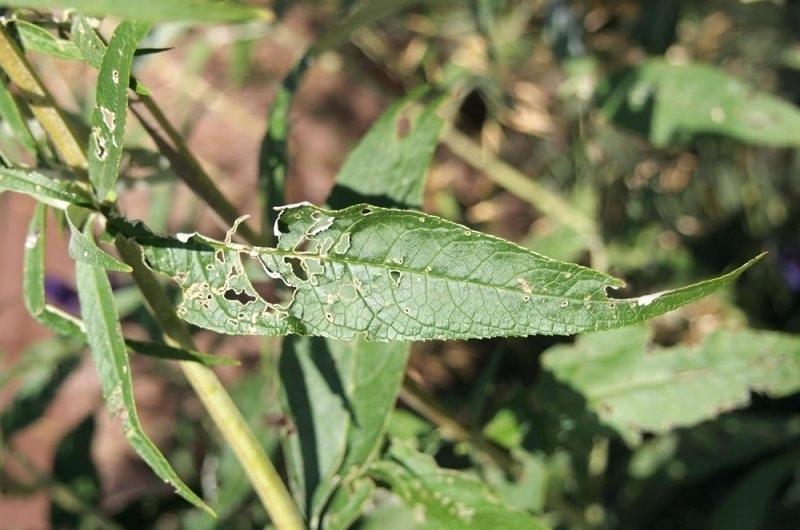
Extended periods of warm weather might not sound destructive, but for food crops and those depending on them, this means war. When temperatures rise, insects can survive and multiply for longer periods, leading to severe infestations.
Wheat, corn, and rice are three of the most consumed crops in the world – accounting for 42 percent of calories eaten worldwide.
Due to increased population growth and accelerated metabolic rates in insects, caused by extended warm periods, these crops are in great danger.
University of Washington climate researcher Curtis Deutsch explains: “Insect pests currently consume the equivalent of 1 out of every 12 loaves of bread (before it ever gets made). By the end of this century, if climate change continues unabated, insects will be eating more than 2 loaves of every 12 that could have been made.”
If the planet continues to warm at its current rate, yield losses will increase around 10-25 percent for every additional degree of global warming.
Increasing temperatures are enough to reduce crop yields alone, but insect infestations could magnify the devastation. On the other hand, if plants and insects cannot adapt to climate change, it could lead to localized extinction.
Insects don’t simply devour plants, they transmit bacteria and fungi that cause diseases with the potential to wipe out entire global plant populations – and possibly human ones too.

Increasing global temperatures impact the growth and cultivation of crops along with the reproductive speeds and severity of various plant pathogens.
Wheat, rice, and corn aren’t the only crops impacted by insect infestations and plant diseases. Farmers are reporting massive losses in potato and soybean yields as well.
In the U.S. alone, the average person is believed to eat 117 pounds of potatoes per year. Those in Europe are estimated to consume double that amount.
A fungus-like water mold caused The Irish Potato Famine of 1845, wiping out nearly 50 percent of potato crops that year. Almost one million people died of starvation and an additional million were forced to leave their homeland as refugees.
Agriculture, including raising animals for food, is referred to as “The Goldilocks Industry” attributed to its sensitivity to extreme weather shifts and decreased yields as a result.
Climate change is causing severe weather that is drenching certain areas, like the Northern U.S. and Canada, and parching others, like the Midwest.
Reduced crop yields are a potentially fatal consequence of climate change and an epidemic in developing countries.
An estimated 9 million people die of hunger or hunger-related diseases every year, which is more than the lives taken by AIDS, malaria, and tuberculosis combined.
Severe drought and low yields are a driving factor in increased migration across the U.S. border, especially in Central America.
Farmers are endlessly researching ways to increase crop yields but severe droughts are quickly killing plants and animals due to dehydration and diseases. This is leading farmers to search for other ways to provide for their families, resulting in less food for the world.
Droughts are not the only causes of food scarcity. Animal agriculture is a leading cause of land degradation, resource use, and deforestation, three major contributors to climate change. A changing climate produces extreme weather events, water scarcity, rising sea levels, and other events that reduce food outputs.
A report from the UN’s Food and Agriculture Organization (FAO) warns that climate change is a major contributor to food scarcity and world hunger. We must tackle this problem before it leads to the demise of plants, animals, and humans.
When raising animals for meat or milk, extensive amounts of freshwater, energy, and arable land are used emitting large amounts of GHGs in the process.
Agriculture may be harmful to the planet, but it is possible to mitigate its effects.
When comparing emissions within the agricultural sector, meat surpasses plant emissions by a longshot. Dairy and eggs produce less emissions than beef, lamb, and pork, but produce over four times the emissions of plant-based protein sources.
Fortunately for the planet, farmers have options when it comes to producing sustainable crops and ethical sources of protein.
Incorporating efficient irrigation systems, growing organic crops, and utilizing renewable sources of energy can considerably reduce the amount of water, energy, and harmful chemicals.
For cattle ranchers and dairy producers, shifting from animal-based foods to plant-based protein sources is one of the most sustainable (and compassionate) efforts imaginable.
Elmhurst Dairy is a prime example of the possibilities and successes of switching to plants. Elmhurst Dairy started in 1925 in New York, but nearly a century later transitioned into producing plant milk and rebranded as Elmhurst Milked.
Other animal producers, like the owners of Sonnen Ranch in Texas, traded meat for mercy and turned their cattle ranch into a farm sanctuary.
Alternately, start-ups like Memphis Meats, JUST, Fork & Goode, BlueNalu, and Finless Foods are creating real meat and seafood products by only using animal cells.
The climate is changing now, but that doesn’t mean we should give up. Transitioning to more sustainable production techniques and investing in new protein rendering technologies are the future of agriculture. They have to be.
Animal agriculture is incredibly destructive to the planet and is a key contributor to climate change. A changing climate threatens the ocean, plants, animals, and natural resources all of us earth-dwellers rely on every day.
In addition to the suffering of billions of farmed animals, wild species around the world are also suffering the consequences of habitat loss, plant diseases, and natural disasters attributed to climate change, fueled by humanity’s habit of eating meat and dairy products.
The choices we make today impact the world we will live in tomorrow. The future of the planet lies on our plates, and the time to act is now.